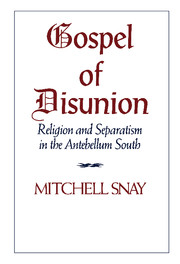Book contents
- Frontmatter
- Contents
- Acknowledgments
- Introduction: Religion and the search for Southern distinctivenes
- PART ONE RELIGION AND SECTIONAL POLITICS
- PART TWO RELIGION AND SLAVERY
- PART THREE RELIGION AND SEPARATISM
- 4 Harbingers of disunion: The denominational schisms
- 5 The religious logic of secession
- 6 Religion and the formation of a Southern national ideology
- Conclusion: Religion, the origins of Southern nationalism, and the coming of the Civil War
- Bibliography
- Index
6 - Religion and the formation of a Southern national ideology
from PART THREE - RELIGION AND SEPARATISM
Published online by Cambridge University Press: 07 September 2010
- Frontmatter
- Contents
- Acknowledgments
- Introduction: Religion and the search for Southern distinctivenes
- PART ONE RELIGION AND SECTIONAL POLITICS
- PART TWO RELIGION AND SLAVERY
- PART THREE RELIGION AND SEPARATISM
- 4 Harbingers of disunion: The denominational schisms
- 5 The religious logic of secession
- 6 Religion and the formation of a Southern national ideology
- Conclusion: Religion, the origins of Southern nationalism, and the coming of the Civil War
- Bibliography
- Index
Summary
The departure of eleven slave states from the Union and the birth of the Confederacy marked the final transformation from Southern sectionalism to Southern nationalism. To those Southern clergymen who chose to defend disunion from the pulpit, the issue of nationalism became inescapable. The secession crisis had forced Southern clerics to diagnose the crisis of the Union and to justify severance from the Union in religious terms. Alongside these themes was the conscious attempt by the clergy to create a new national identity. It became one of the main purposes behind the fast day sermons and political editorials in denominational newspapers. This emerging national self–consciousness serves as an appropriate conclusion to the study of the relationship between religion and the development of Southern separatism. It provides another angle from which to view the ways in which clergymen wove religion into a distinctive Southern identity.
The creation of Southern religious nationalism can best be appreciated through a direct comparison between the writings of Northern and Southern clergymen. A comparative strategy has several advantages. It is the most practical and reliable way to determine what is distinctly “Southern” in the writings of Southern ministers. It is also invaluable in understanding the origins of Southern religious nationalism during the winter and spring of 1860–1. The North was essential to the creation of a Southern national identity.
- Type
- Chapter
- Information
- Gospel of DisunionReligion and Separatism in the Antebellum South, pp. 181 - 210Publisher: Cambridge University PressPrint publication year: 1993

